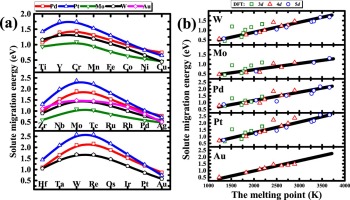当前位置:
X-MOL 学术
›
Comp. Mater. Sci.
›
论文详情
Our official English website, www.x-mol.net, welcomes your
feedback! (Note: you will need to create a separate account there.)
Trends in transition metal solute diffusion in metals: The case of tungsten
Computational Materials Science ( IF 3.1 ) Pub Date : 2020-06-01 , DOI: 10.1016/j.commatsci.2020.109638 Xiang-shan Kong , Kang-ni He , Jie Hou , T. Zhang , C.S. Liu
Computational Materials Science ( IF 3.1 ) Pub Date : 2020-06-01 , DOI: 10.1016/j.commatsci.2020.109638 Xiang-shan Kong , Kang-ni He , Jie Hou , T. Zhang , C.S. Liu

|
Abstract The solute diffusion regulates many properties and phenomena of metal alloys. Decades of research has led to lots of knowledge of interrelationships between diffusion parameters and transition metal (TM) solutes properties in metals. But none has provided a universal relationship to elucidate the underlying physics of TM solute diffusion in metals. In this paper, we systematically study TM solutes diffusion in tungsten using the first-principles calculations coupled with harmonic transition state theory. We found the solute migration energies vary parabolically across the TM series reaching a maximum at V, Mo, and W for 3d, 4d, and 5d, respectively. The correlation factor is temperature-dependent in an Arrhenius-like way, whose fitted correlation energies and pre-factors are inversely proportional to the solute migration energies. Using the database of TM solute diffusion in tungsten developed here and other existing databases, we identify the role of the matrix metals on the law of solute diffusion. When the atomic radii of matrix metals are larger than TM solutes, the solute diffusion is dominated by metallic bonds between the solute and matrix atoms, whose solute migration energy follows a positive correlation to the melting point of the solute element. While for the reverse case, the solute diffusion is controlled by solute-induced lattice distortions and their solute migration energy shows a negative correlation with the solute radius.
中文翻译:

金属中过渡金属溶质扩散的趋势:以钨为例
摘要 溶质扩散控制着金属合金的许多性质和现象。数十年的研究使人们对扩散参数与金属中的过渡金属 (TM) 溶质特性之间的相互关系有了大量了解。但是没有一个提供通用的关系来阐明金属中 TM 溶质扩散的基本物理学。在本文中,我们使用第一性原理计算结合调和过渡态理论系统地研究了钨中的 TM 溶质扩散。我们发现溶质迁移能量在整个 TM 系列中呈抛物线变化,分别在 3d、4d 和 5d 的 V、Mo 和 W 处达到最大值。相关因子以类似 Arrhenius 的方式依赖于温度,其拟合相关能和预因子与溶质迁移能成反比。使用此处开发的钨中 TM 溶质扩散数据库和其他现有数据库,我们确定基质金属对溶质扩散定律的作用。当基体金属的原子半径大于TM溶质时,溶质扩散以溶质与基体原子之间的金属键为主,其溶质迁移能与溶质元素的熔点呈正相关。而在相反的情况下,溶质扩散受溶质诱导的晶格畸变控制,其溶质迁移能量与溶质半径呈负相关。溶质扩散主要由溶质和基体原子之间的金属键控制,其溶质迁移能量与溶质元素的熔点呈正相关。而在相反的情况下,溶质扩散受溶质诱导的晶格畸变控制,其溶质迁移能量与溶质半径呈负相关。溶质扩散主要由溶质和基体原子之间的金属键控制,其溶质迁移能量与溶质元素的熔点呈正相关。而在相反的情况下,溶质扩散受溶质诱导的晶格畸变控制,其溶质迁移能量与溶质半径呈负相关。
更新日期:2020-06-01
中文翻译:

金属中过渡金属溶质扩散的趋势:以钨为例
摘要 溶质扩散控制着金属合金的许多性质和现象。数十年的研究使人们对扩散参数与金属中的过渡金属 (TM) 溶质特性之间的相互关系有了大量了解。但是没有一个提供通用的关系来阐明金属中 TM 溶质扩散的基本物理学。在本文中,我们使用第一性原理计算结合调和过渡态理论系统地研究了钨中的 TM 溶质扩散。我们发现溶质迁移能量在整个 TM 系列中呈抛物线变化,分别在 3d、4d 和 5d 的 V、Mo 和 W 处达到最大值。相关因子以类似 Arrhenius 的方式依赖于温度,其拟合相关能和预因子与溶质迁移能成反比。使用此处开发的钨中 TM 溶质扩散数据库和其他现有数据库,我们确定基质金属对溶质扩散定律的作用。当基体金属的原子半径大于TM溶质时,溶质扩散以溶质与基体原子之间的金属键为主,其溶质迁移能与溶质元素的熔点呈正相关。而在相反的情况下,溶质扩散受溶质诱导的晶格畸变控制,其溶质迁移能量与溶质半径呈负相关。溶质扩散主要由溶质和基体原子之间的金属键控制,其溶质迁移能量与溶质元素的熔点呈正相关。而在相反的情况下,溶质扩散受溶质诱导的晶格畸变控制,其溶质迁移能量与溶质半径呈负相关。溶质扩散主要由溶质和基体原子之间的金属键控制,其溶质迁移能量与溶质元素的熔点呈正相关。而在相反的情况下,溶质扩散受溶质诱导的晶格畸变控制,其溶质迁移能量与溶质半径呈负相关。











































 京公网安备 11010802027423号
京公网安备 11010802027423号